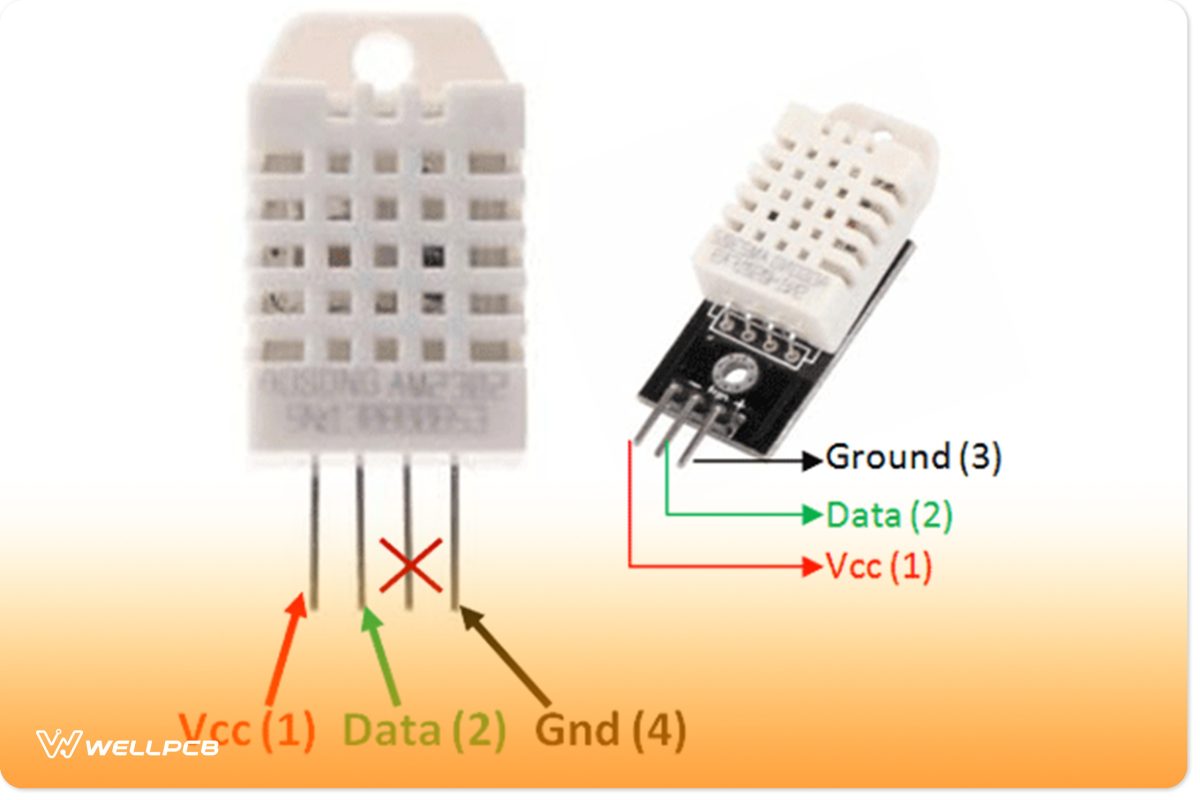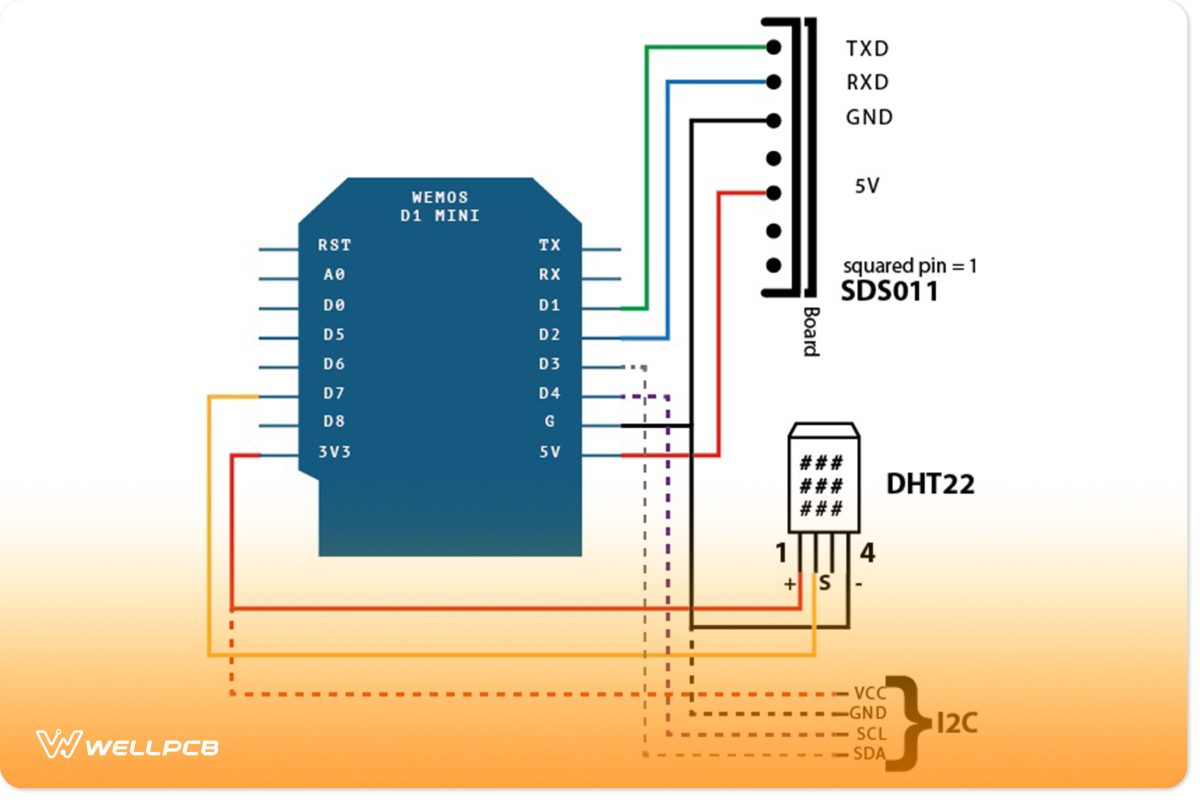Contents
What is DHT22?
The DHT22 is a simple temperature and humidity sensor with a digital display. It measures the ambient air with a capacitive humidity sensor and a thermistor and outputs a digital signal on the data pin, requiring no analog input pins.
Pin Specifications and Configurations
The DHT22 is a simple temperature and humidity sensor with a digital display. It measures the ambient air with a capacitive humidity sensor and a thermistor. And it outputs a digital signal on the data pin, requiring no analog input pins.
Pin Configuration
| No | Pin Name | Description |
| DHT22 Module | ||
| 1 | VCC | It has a power supply of 3.5V to 5.5V. |
| 2 | Data | The temperature and humidity output signals via serial data. |
| 3 | Ground | The module usually connects to the ground of a circuit. |
| DHT22 Sensor | ||
| 1 | VCC | It also has a power supply voltage of 3.5V to 5.5V |
| 2 | Data | The humidity and temperature output via serial data. |
| 3 | NC | Not applicable because it has no connection. |
| 4 | Ground | The DHt22 humidity sensor specs also connect to the ground of a circuit. |
DHT22 Specifications
- It operates on 3.5 to 5.5 volts.
- The standby operating voltage current is 60uA, while the measuring is 0.3mA.
- Serial data acts as the output.
- The temperature measuring range is around -40°C to 80°C.
- Temperature and humidity are both 16-bit resolutions.
- -0.5°C accuracy and 1 percent accuracy.
Difference Between DHT22 Sensor and Module
The sensor comes with a 4-pin package, and only three pins are functional, while the module only comes with an applicable 3-pin package. See the illustration of the AM2302 sensor pinout below.

Besides, you will also notice that the module has an inbuilt pull-up resistor and a filtering capacitor. However, these are not inbuilt for the sensor, and you can only use them externally whenever required.
The module is slightly more expensive than the DHT11, but it has a more comprehensive measurement range and superior precision.
Where Can You Use DHT22 Pinout?
The DHT22 uses minimal electricity because it is compact, and Additionally, the length of its transmission is roughly 20 meters. The primary application of the DHT22 sensor is to help in measuring the ambient temperature and humidity.
As much as DHT11 can perform the same job and give almost similar results, most people find the DHT22 more dependable. This device is pre-calibrated and has built-in digital temperature compensation.

They build these sensors to be functional in various severe environments, and you can easily interface the devices with microcontrollers or Arduino UNO.
Moreover, this sensor would be appropriate for use in an application that requires a sensor to detect the temperature in the range. Here are the preferable sensor readings -40°C to +125°C or to monitor humidity.
How to Use DHT22
When opening the DHT22/AM2302 sensor or DHT11 sensor, you’ll notice two sensing elements: an NTC (thermistor) and a humidity sensor.
Besides, the humidity sensor device has two electrodes connected by a moisture-holding substrate. One can measure the resistance between the electrodes using the sensor. However, the results are not constant because it depends on the temperature and moisture values in the air.
If you check at the back of the sensor, you will find/see a tiny IC that helps measure and process the analog signal. Moreover, the IC helps convert the measurements from analog to digital and store the calibration coefficients.
Connection of DHT22 with Any Microcontroller
You don’t need any electrical components to complete the connections. The device comes with four pins, but one of them is not a connecting pin. However, the good news is that you can connect any microcontroller to the functional three pins.
The DHT22 runs in a serial asynchronous mode since it lacks a clock pin. Therefore, keeping it in high logic requires a pull-up resistor between the data line and the ground.
Besides, you will require a pull-up resistor between the sensor and the microcontroller for accessible serial communication.

Microcontroller
Interfacing the Sensor with PIC Microcontroller
You can connect this sensor directly to a PIC microcontroller or an Arduino since the breakout board has an integrated pull-up resistor.
The diagram below uses a PIC18F25K20 type of program to receive data from a DHT22 sensor through the RAO pin. You can also use a pull-up resistor with humidity readings of 4.7k or 10k. Moreover, you can now connect the PIC18F25K20’s RA0 pin to the data output pin. Below is a connection between a DHT22 sensor and a PIC microcontroller.
Applications for the DHT22
- You can use the DHT22 sensor in the HVAC industry.
- Testing and inspection equipment.
- Home appliances and consumer products to measure temperature and humidity range.
- Used in the medical units to detect humidity levels of patients in isolation wards.
- To monitor the weather, fax machines, refrigerators, food processing devices, among others.
- In Pharmaceutical units, ensure the humidity levels are at acceptable limits.
- Automatic climate control.
- Medical devices to assess air humidity levels for patients who suffer from certain lung diseases.

HVAC System
Summary
It would help if you did not worry about your indoor or outdoor weather monitoring anymore. The DHT22 provides a cost-effective alternative to traditional hygrometers. They are relatively cheap and have wide temperature and humidity ranges, applicable in several settings.
Whether you need the sensor module for HVAC, home appliances (like a fridge), weather monitoring, or other projects, you’ll need specialized production. So, calibrating the DHT22 to your project’s specifications will ensure efficiency and practicality.
Now, you know everything about the DHT22 sensor module. You can now finish your projects that may require temperature and humidity sensors-at affordable prices.
If you have any questions about the DHT22 pinout, please get in touch with us!





